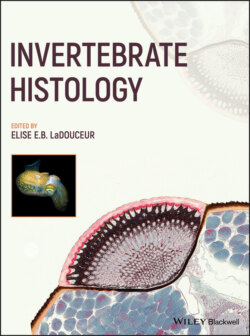Читать книгу Invertebrate Histology - Группа авторов - Страница 23
1.3.8 Nervous System
ОглавлениеThe nervous system in echinoderms lacks ganglia, which are present in most other invertebrate species. The central nervous system in asteroids consists of a central circumoral ring and five radial nerves that extend within the center of the ambulacral groove to the tip of each ray. Each have a sensory and a motor component. The peripheral nervous system consists of the intraepithelial nerve nets previously described in the body wall. The sensory ectoneural nerve net extends along the epidermis and the motor hyponeural nerve net extends along the coelomic epithelial lining. These nerve nets are connected by neurons that cross the dermis. In Echinoidea, the ectoneural nerve system is the main component and consists of a circumoral nerve ring, radial nerves, podial nerves, and subepidermal nerve plexus. The radial nerves arise from the circumoral nerve ring and extend through the lantern and along the ambulacral plates, coursing between the radial canal and test. Radial nerves give rise to podial nerves that supply the tube feet. The hyponeural nerve system is a series of five radially positioned plaques of nervous tissue below the circumoral nerve ring. Some regular sea urchins have an entoneural nerve system consisting of a nerve ring around the periproct which gives rise to innervation of the gonads.
Histologically, the nerve ring and radial nerves of Asteroidea and Echinoidea have a distinct outer sensory layer, which communicates with the ectoneural system, and an inner hyponeural layer, which communicates with the motor components. The motor portions of the radial nerve innervate the ampullae, tube feet, and body wall musculature. In all other echinoderm classes other than Asteroidea, the circumoral nerve ring and radial nerve cords have been internalized. The ectoneural portions of the circumoral nerve ring and radial nerves are further isolated in a specialized epineural canal, which is lined by ciliated epithelium (Figure 1.24).
